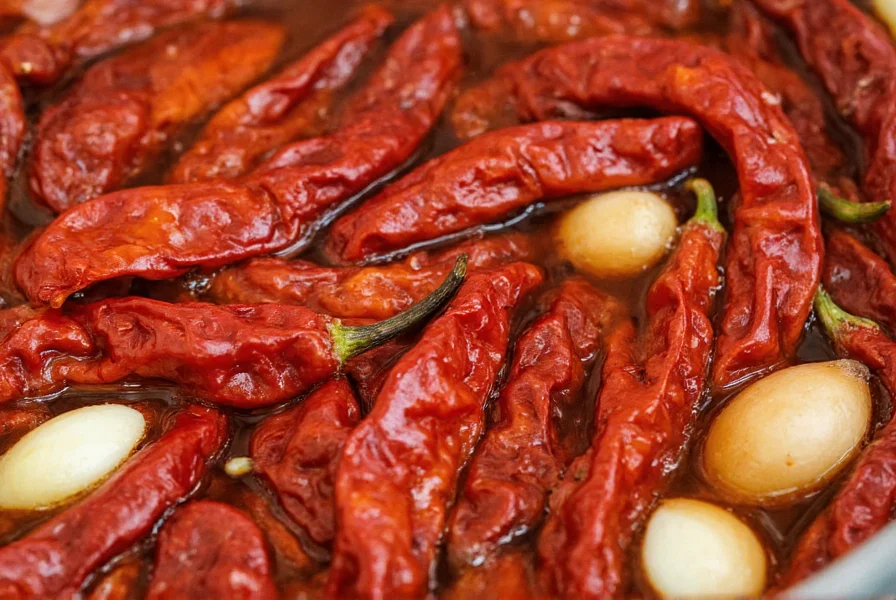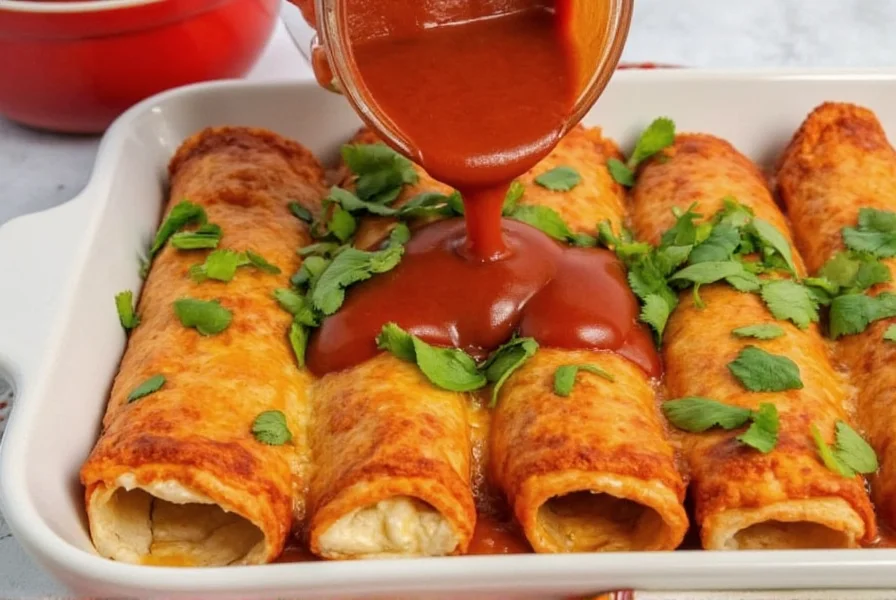When exploring how to make guajillo pepper sauce from scratch, understanding the unique characteristics of guajillo peppers is essential. These dried mirasol peppers provide the base for one of Mexico's most versatile sauces, balancing subtle heat with complex fruit-forward notes that distinguish it from other chili-based sauces.
Understanding Guajillo Pepper Characteristics
Guajillo peppers (chiles guajillos) rank between 2,500-5,000 on the Scoville scale, placing them in the mild-to-medium heat category—comparable to a jalapeño but with significantly more nuanced flavor. When properly prepared, guajillo pepper sauce delivers a distinctive combination of:
- Berry-like sweetness with cranberry and raspberry notes
- Subtle green tea and tamarind undertones
- Earthy, slightly smoky depth
- Medium-bodied texture that coats ingredients beautifully
Unlike hotter chili varieties, guajillo peppers provide flavor complexity without overwhelming heat, making them ideal for family-friendly Mexican recipes using guajillo sauce. Their thin skin rehydrates quickly, creating a smooth sauce that doesn't require extensive straining.
Essential Ingredients for Authentic Guajillo Sauce
Creating the best guajillo pepper sauce requires minimal ingredients but precise technique. For a standard batch serving 6-8:
| Ingredient | Quantity | Preparation Notes |
|---|---|---|
| Dried guajillo peppers | 8-10 whole | Stemmed and seeded; avoid broken or moldy peppers |
| Garlic cloves | 3-4 | Roasted for deeper flavor |
| Onion | ½ white onion | Raw or lightly sautéed |
| Tomatoes | 1 Roma tomato | Roasted for acidity balance |
| Oil | 1 tbsp | Neutral oil like avocado or grapeseed |
| Water or broth | 1½ cups | For rehydrating and consistency |

Step-by-Step Preparation Guide
Follow these professional techniques for perfect guajillo pepper sauce every time:
1. Proper Pepper Preparation
Remove stems and seeds from dried guajillos using scissors and a spoon. Place peppers in a bowl and cover with boiling water. Weight them down with a plate to ensure full submersion. Soak for exactly 15 minutes—any longer and the sauce becomes bitter. Reserve 1 cup of soaking liquid for blending.
2. Flavor Development
Heat oil in a skillet over medium heat. Add rehydrated peppers (pat dry first) and toast for 2 minutes per side until fragrant but not browned. This crucial step (often missed in guajillo sauce recipes) enhances the natural fruit notes while reducing any potential bitterness.
3. Blending Technique
Combine toasted peppers, roasted garlic, onion, tomato, 1 cup soaking liquid, and ½ cup fresh water in a high-speed blender. Blend on high for 2-3 minutes until completely smooth. For restaurant-quality texture, strain through a fine-mesh sieve, pressing with a spatula to extract maximum liquid.
4. Final Simmering
Pour strained sauce into a clean saucepan. Simmer uncovered for 10-15 minutes to concentrate flavors and achieve proper consistency. The sauce should coat the back of a spoon. Season with salt to taste—typically ½-¾ teaspoon per batch.

Storage and Shelf Life Guidelines
Properly stored guajillo pepper sauce maintains quality for different durations depending on method:
- Refrigeration: Store in airtight container for up to 1 week. The acid content from tomatoes helps preservation.
- Freezing: Portion into ice cube trays, then transfer frozen cubes to freezer bags for up to 6 months. Ideal for meal prep with guajillo sauce.
- Canning: Not recommended due to pH levels unless following tested canning protocols with added acid.
When reheating frozen sauce, do so gradually over low heat to prevent separation. Stir in a teaspoon of water if needed to restore consistency.
Culinary Applications and Pairing Suggestions
Guajillo sauce's balanced flavor profile makes it remarkably versatile. Move beyond basic enchilada sauce using guajillo peppers with these professional applications:
Traditional Mexican Dishes
- Enchiladas suizas: Use as base for chicken enchiladas instead of tomatillo sauce
- Tamales: Mix into masa or use as steaming liquid for added flavor
- Carne asada: Marinate grilled meats or serve as table-side condiment
- Chilaquiles: Create a less acidic alternative to traditional red chilaquiles
Modern Culinary Innovations
- Breakfast: Drizzle over huevos rancheros or breakfast burritos
- Seafood: Pair with grilled fish or shrimp tacos
- Vegan cooking: Use as base for mushroom or jackfruit "carnitas"
- Cocktails: Add complexity to micheladas or bloody marys
Common Substitutions and Troubleshooting
When perfecting your homemade guajillo pepper sauce technique, address these frequent challenges:
Ingredient Substitutions
- No guajillo peppers: Combine 50% ancho (sweetness) and 50% pasilla (fruit notes) peppers
- Too spicy: Add 1 teaspoon honey or ¼ cup roasted red bell pepper
- Too thin: Simmer longer or add 1 tsp masa harina
- Bitter taste: Balance with ½ tsp apple cider vinegar and 1 tsp sugar
Texture Issues
For a completely smooth sauce without straining, blend while hot and use a high-powered blender. If sauce separates after storage, re-emulsify by blending with 1 teaspoon neutral oil while reheating.
Frequently Asked Questions
Can I use guajillo pepper sauce as a substitute for adobo sauce?
While both are Mexican red sauces, guajillo sauce lacks the vinegar and spice blend of traditional adobo. For substitution, add 1 teaspoon vinegar and ¼ teaspoon each of cumin and oregano per cup of guajillo sauce to approximate adobo's flavor profile.
Why does my guajillo sauce taste bitter?
Bitterness typically comes from over-soaking peppers (beyond 15 minutes) or burning them during toasting. To fix bitter sauce, balance with ½ teaspoon apple cider vinegar and 1 teaspoon sugar while simmering. Always remove seeds thoroughly as they contain most bitterness.
How can I make guajillo sauce less spicy for children?
Guajillo peppers are naturally mild, but for extra precaution, remove all white ribs and seeds before soaking. You can further reduce heat by adding ¼ cup roasted red bell pepper to the blender. The sauce's natural fruitiness means most children enjoy it without modification.
What's the difference between guajillo and ancho pepper sauces?
Guajillo sauce offers brighter, fruitier notes with berry and green tea undertones (2,500-5,000 SHU), while ancho sauce provides deeper chocolate and coffee flavors with less acidity (1,000-2,000 SHU). Guajillo creates thinner, more pourable sauces ideal for enchiladas, while ancho yields thicker, richer sauces better for moles.
Can I can guajillo pepper sauce for long-term storage?
Canning requires precise pH control (below 4.6) for safety. Most guajillo sauce recipes need added acid (like 1 tablespoon lemon juice per pint) to reach safe canning levels. Without proper acidification, freezing remains the safest long-term storage method for homemade guajillo sauce.











 浙公网安备
33010002000092号
浙公网安备
33010002000092号 浙B2-20120091-4
浙B2-20120091-4